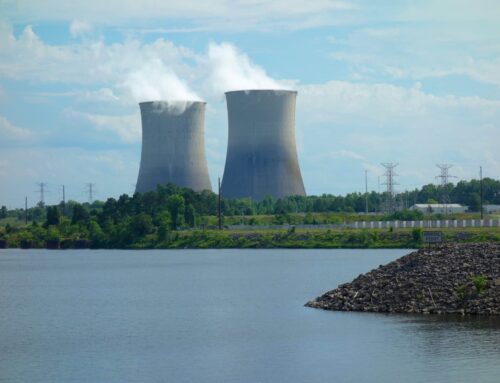The U.S. House of Representatives’ FY2025 budget reconciliation bill, known as the One Big Beautiful Bill Act, would sunset the nuclear production tax credit (Section 45U) one year earlier than under current law, but it also includes special exemptions that would allow nuclear facilities to claim clean electricity production and investment credits for longer. These provisions were introduced at the last minute during the House Rules Committee’s May 21 markup and passed by the full House the following day.
The final bill eliminates the previously proposed phase-out of the Section 45U Zero-Emission Nuclear Power Production Tax Credit, instead setting a hard cutoff at the end of 2031. While this earlier sunset is projected to save taxpayers $3.8 billion, that’s $6.7 billion less in savings over the next decade compared to the Ways and Means Committee’s original proposal. The bill also adds carve-outs for nuclear energy under the 45Y Clean Electricity Production Credit and the 48E Clean Energy Investment Credit, allowing nuclear facilities to continue claiming these credits long after other energy sources are phased out.
Don’t be fooled. While ending 45U a year early would modestly increase tax revenue, taxpayers are still poised to funnel billions into nuclear subsidies. As the reconciliation package moves to the Senate, lawmakers must scrutinize these giveaways to ensure they deliver real value—not more waste.
Section 45U Zero-Emission Nuclear Power Production Credit
The Section 45U tax credit provides up to $15 per megawatt-hour (MWh) of electricity produced and sold by qualifying nuclear power facilities, with the credit reduced for plants that earn more income from electricity sales. The credit applies to electricity produced after calendar year 2023 and is currently set to expire at the end of 2032. When it was created, the Joint Committee on Taxation (JCT) estimated it would cost taxpayers $30 billion from FY2022 to FY2031.
An earlier draft of the One Big Beautiful Bill Act, as passed by the House Ways and Means Committee, proposed a phase-out schedule: the credit would be reduced by 20% in 2029, 40% in 2030, and 60% in 2031, before expiring in 2032. That draft also introduced new restrictions on entities linked to foreign entities of concern (FEOC) and repealed credit transferability—which allows entities to transfer all or a portion of an eligible credit to an unrelated taxpayer—after two years. The Congressional Budget Office (CBO) estimated these changes would save taxpayers $10.4 billion from FY2025 to FY2034.
However, the final bill passed by the House stripped out the phase-out schedule and instead sunsets the 45U credit one year early—at the end of 2031. It reinstates transferability but retains the FEOC restrictions. The JCT now estimates the House-passed version would save just $3.8 billion from FY2025 to FY2034—roughly $6.7 billion less than the original proposal.
Special Treatment for Nuclear in 45Y and 48E Tax Credits
The One Big Beautiful Bill Act delivers a last-minute windfall to new and existing nuclear power plants through the 45Y Clean Electricity Production Tax Credit and the 48E Clean Energy Investment Tax Credit.
Section 45Y provides up to $0.015 per kWh for electricity produced from qualified sources with zero greenhouse gas (GHG) emissions. Section 48E offers up to a 30 percent investment tax credit for qualifying zero-emission generation and energy storage projects. Under current law, both credits start phasing out for facilities that begin construction after the later of 2032 or when the U.S. electricity sector meets its emissions reduction goal.
An earlier draft of the One Big Beautiful Bill Act, as passed by the House Ways and Means Committee, would have moved up the phaseout period and restricted eligibility to facilities placed in service before 2032. It also applied new FEOC restrictions and repealed transferability after two years.
The House-passed bill takes a different path. It sunsets eligibility for 45Y and 48E much earlier, restricting the credits to facilities that both begin construction within 60 days of the bill’s enactment and are placed in service before 2029—seven years earlier than current law. But advanced nuclear projects receive a special exemption: facilities that begin construction before 2029 remain eligible, with no deadline for when they must be placed in service. This exemption applies to both new builds and expansions of existing facilities under 45Y, though only new facilities qualify under 48E. The bill would also reinstate transferability for both credits, while retaining the FEOC restrictions.
Continued Nuclear Subsidies Come at a High Cost to Taxpayers
The House-passed One Big Beautiful Bill Act would leave the Section 45U nuclear production tax credit largely intact, merely ending it one year earlier than under current law—without the more meaningful phase-out previously proposed. At the same time, the bill would extends preferential treatment for nuclear energy under Sections 45Y and 48E by making eligibility contingent only on when construction begins, without requiring facilities to be placed in service by a specific date. This carve-out does not apply to other energy sources.
The bill also restores credit transferability for nuclear facilities under 45U, 45Y, and 48E—granting them more flexibility than other energy or power producers. In contrast, the bill would repeal transferability for other major energy incentives, including the Section 48 Energy Investment Tax Credit, 45Q Carbon Oxide Sequestration Credit, 45X Advanced Manufacturing Tax Credit, and 45Z Clean Fuel Production Credit.
The nuclear industry has long relied on generous federal support—including Department of Energy research and development funding, liability protections through the Price-Anderson Act, and federal loan guarantees. Despite this, nuclear energy remains among the most expensive power sources. Continued subsidies risk crowding out cheaper, more efficient alternatives and could saddle taxpayers with billions in unnecessary risks and costs every year.
- Photo by Mick Truyts on Unsplash










